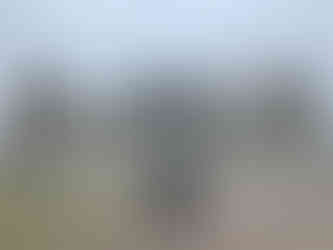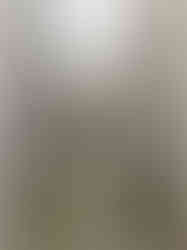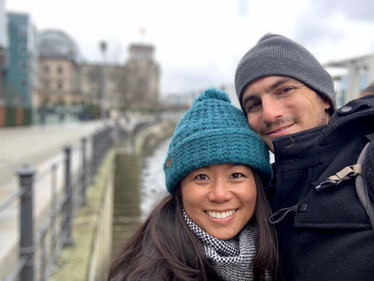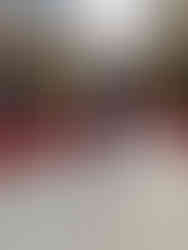From East to West and Back: Berlin, Germany
- tangio
- Jul 19, 2020
- 9 min read
Berlin reveals itself like the speckled panels of its infamous Wall: deep history covered in dirt and grime; gray skies that blend into gray concrete, interrupted by the angsty bursts of colored graffiti and protest marches; old world vestiges that sit next to the sharp edges and clear glass of modern new buildings.

We admit that it was a bit of a culture shock arriving in Berlin after traveling six months through Central and Southeast Asia. If nothing else, our bodies were shocked from the damn cold. We had become accustomed to Southeast Asia’s daily 95°F temperatures with 100% humidity, the thick layer of sticky sweat on our skin having grown into a permanent coat. After a “Scoot” (the actual name of the Singapore-based budget airline that we flew from Singapore to Berlin) across the massive landmass of Eurasia, that layer quickly evaporated and was replaced with real coats (borrowed from our friends) when we landed in the early morning chill of Berlin in mid-March, our breaths visible in the low 30s° F temperatures.
With COVID-19 mildly spreading in Southeast Asia and looming large in Europe at that time, travel was starting to change and our original flights from Singapore to Morocco (our next destination) had been canceled. The next best and cheapest itinerary transited through Berlin, where neither of us had ever been and where our friends were living for the year—so we jumped at the opportunity to extend our layover and spend a few unexpected days here. Despite the cold, we’re very glad we did.

For three days, we ambled through the unique narrative of this capital city of over 3.5 million people, through cold wet rain and short winter days—both of which made the warm towel bar and homecooked meals in the home of our friends Ben and Jess, where we stayed in the up-and-coming artsy neighborhood of Neukölln, all the more cozy and welcoming. Between requisite visits to historical sites, we also enjoyed other, more quirky quintessential Berlin-isms, like the popular antiques flea market, a pay-what-you-want progressive vegan brunch buffet frequented by the kinds of hipsters that would make even Brooklyn blush, and schnitzel dinner night with friends on a mission to find the biggest schnitz in the city.
Through it all, we saw a very developed and Westernized Berlin today, but we also caught hints of the legacy of a divided Germany and a stunted East German economy. In the space between these two identities, both the grit and conscientiousness of a people who have lived through these divisions and conflicts showed through. Indeed, walking around Berlin felt like watching a young adult tell its own coming-of-age story.

As a quick history reminder: Berlin was the seat of Nazi Germany during WWII until their surrender in 1945, when the winning Allies initially split Germany into four military occupation zones, with Britain, France, the U.S., and the Soviet Union each controlling a zone. But the end of one war brought the beginning of another; with the tensions of the Cold War already mounting, the Western Allies and the Soviets had increasingly different intentions for post-war Germany. In 1949, in an almost perfect experiment of economic theories, the Western Allies established a parliamentary democracy and capitalist economy in West Germany, while the Soviet zone in East Germany became a Marxist-Lenin socialist state. Though Berlin itself sat deep within East Germany’s borders, it, too, was divided into four zones mirroring the four occupation zones and East-West split of the country.

Despite being geographically isolated from the rest of West Germany, West Berlin enjoyed strong relationships with West Germany and the Western Allies, participating in the West German Parliament and enjoying elevated economic opportunities and productivity that ultimately surpassed pre-war levels. Over the course of twelve years, millions of East German citizens saw the progress across the dividing line and left for the West in search of better opportunities, ultimately leading to the East’s construction of the Berlin Wall in order to prevent further migration of skilled laborers and professionals from East Berlin to West Berlin (interestingly, today there is almost a reverse migration of sorts, with many Berliners flocking to live in the more affordable and hip neighborhoods of the East). One of the most visible and memorable symbols of the Cold War, the Berlin Wall was not dismantled until 1989, heralding the fall of the Soviet Union and the reunification of Germany in 1990. (Fun fact: we were both in first grade when the Berlin Wall came down, and Karen’s class erected a paper “Berlin Wall” across her classroom for the day, with students taking turns “living” and learning on both sides of the Wall before tearing it down together at the end of the day and hugging friends on the other side; Karen was photographed graffitiing the west side of the Wall for the local county newspaper.)
Berlin is not shy about this history, whether positive or negative, and reminded us of it everywhere—in ample street signage, museum plaques, and government audio tours. In fact, Berlin taught us that, sometimes, it’s best to just say the facts, and move on. The candor—indeed, almost brusqueness—with which its museum and government signage used to explain its history was surprisingly blunt, but we appreciated the honesty and self-awareness. For example, inside the Dome of the Reichstag, the description of the complex and difficult history of Nazi Germany is succinct and straight to the point:
The National Socialists destroy democracy: they rescind basic rights and establish a dictatorship led by Hitler. Terror and propaganda dominate politics and daily life in the “Third Reich.” The Nationalist Socialists systematically persecute, arrest and murder millions of people.
The Second World War unleashed by the German Reich claims over 50 million lives. It ends with the unconditional surrender of the Wehrmacht on 8 May 1945.
That’s it—simple, strong, and no mincing of words.
As another example, the Holocaust memorial in Berlin is named, “Memorial to the Murdered Jews of Europe,” while another nearby monument is called, “Memorial to Homosexuals Persecuted Under Nazism.”
No flowery name or glossing over of the facts. No attempts to linger on excuses or past grievances. Berlin owns its past, including the mistakes and ugly parts. It has learned from it in order to make amends and to move forward. From our point of view—in an America today that still cannot honestly talk about, admit to, teach, or wrestle with its own historical wrongdoings, such as slavery-fueled capitalism, institutional racism, or questionable international meddling—seeing Berlin and Germany address this in such a different way—head on, consistently, and matter-of-factly—was refreshing, even if the content was sobering.
Candid communications aside, these two sites were among the most memorable for us in Berlin for other reasons, too. The Reichstag is a late-19th century government building that housed the original parliament of the German Empire before it was gutted in a fire in 1933. It was left unused during and after WWII and was only restored after German reunification. And what a restoration!—completed in 1999, it once again houses the current German Parliament (the Bundestag), which meets in a large hall at its center, within old storied walls but underneath a new futuristic glass dome top. The brilliant Reichstag Dome is quite an engineering feat, offering full panoramic views of the Berlin cityscape outside, while offering glimpses into the inner workings of the government inside. German citizens can freely go up to the Dome and look down at their elected officials as they conduct business, while the Dome’s massive electronic sun shield, automatically tracking to the movement of the sun, keeps the legislators shaded. There are few metaphors better manifested architecturally than the superimposition of a literal transparent globe over its governing body.
In addition to (at least the semblance of) government accountability, the Reichstag Dome also features a superb free audio tour detailing the history of Berlin and Germany told through the lens of the city’s buildings and landmarks, all of which can be viewed from the spiraling walkway that winds its way up the sides of the Dome. The audio tour is location-based, so it only starts talking about specific buildings and history once the listener is standing at a certain point directly in front of and looking at the structures discussed (without the listener needing to press any buttons). As cityscape and architecture geeks, we were impressed with the entire experience—even before the clouds parted and a beautiful sunset filtered through the thick glass panels just as we arrived at the highest level of the Dome, providing us a grand finale to the history show.
Not too far away, the Memorial to the Murdered Jews of Europe during the Holocaust is another thoughtful architectural statement. The memorial consists of 2,711 large unmarked concrete blocks, all seemingly the same height when seen from above, but standing on different ground levels of a sloping and undulating field. Placed in a grid, the slabs start as low as ankle-high around the perimeters, but as we walked down into the long rows between the slabs, going deeper and deeper into the field, they quickly became head-high and then taller still, creating the experience of walking through a graveyard and then being inside the graves themselves. A key feature of the memorial is the visitors interacting with the slabs—from up top, the resulting image is that of many bodies seemingly disappearing into the ground; from within, fellow visitors appeared in our field of vision for only a second as their path intersected with ours, before dissolving behind another concrete slab again, like a ghost in a maze or a whisper in the wind. The result was eerily effective. Again, the metaphor of this design was not subtle: six million Jews disappeared during the Holocaust, in our lives one minute and then vanished the next, before we could even see or identify them.

The rest of our time in Berlin was a third sight-seeing, a third meandering, and a third ducking into cafes and bars to stay warm and dry. In this manner, we ticked off a bunch of sights in quick succession over several afternoons: the historical 18th century Brandenburg Gate; the lively central public square of Alexanderplatz; Museum Island, a small island in the Spree River dedicated to a cluster of five museums and the striking Berlin Cathedral (we didn’t end up visiting any of the actual museums themselves, but we saw them from the outside!); Checkpoint Charlie, the famous crossing of the Berlin Wall between East and West in the American zone of the city, which today features stereotypical marks of American life such as McDonald’s and KFC restaurants; Potzdamer Platz, the public square that sat in disrepair when the Berlin Wall cut through it, but that rebounded as a large development of fancy corporate buildings from behemoths like Daimler and Sony, meant to declare Berlin’s re-emergence back into the modern world (while the overall development felt a bit hollow, the buildings themselves are impressive architecturally, especially the Sony Center’s conical steel roof over an outdoor atrium and use of modern glass over historical building facades); and the Topography of Terror, another somber but informative history museum built on the site of the former headquarters of the Gestapo and the SS, which features the longest continuous section of the exterior Berlin Wall today.

We learned a lot from these sites, but as with all cities we visit, we learned and enjoyed the most when we steered away from the formal destinations and stumbled into the everyday gems that make a community: the spray-paint artists and skateboarders hanging out at grittier segments of the Berlin Wall in Mauerpark; the unexpected accessible bell tower with expansive views of the city at Zionskirchplatz, a local 19th century church in a cute European square; the imaginative graffiti-filled alley outside of a small Anne Frank museum; the Neukölln waiter who served us delicious brunch while wearing a “no one is illegal” sweatshirt; the array of fresh-baked strudels from the neighborhood bakery; the fact that it was almost easier to find vegan burgers than traditional German bratwurst in the Markthalle Neun (indoor food market); and of course, the public poster of David Hasselhoff proclaiming “I love you” to celebrate Women’s Day, just before the Women’s Day parade marched downtown with signs and shouts condemning the patriarchy.

These snippets of Berlin life only left us wanting to understand more. At large, Berlin society seems to display compulsory rigidity and no-nonsense, embodying much of what the world often expects of Germany—unapologetic frankness, punctual trains on the S-Bahn and U-Bahn public transit system, no pedestrian crossing until the pedestrian light turns green, even if there are no cars. At the same time, there are built-in societal release valves that soften that pressure and allow for unique revelry only found here—wild discotheques and dance clubs on Sunday mornings, widely accepted public nudity favoring the Free Body Culture, ample holidays off work and expected long vacations every single season (not every year, every season). Our time in Berlin was too short to experience the depth of this identity, so for now, its multilayered historical sites and vibrant streets will have to be sufficient proxies.
We bid farewell to our friends and left Berlin on the early morning of March 11, 2020. Just days later, everything we had experienced there came to a screeching halt as the country went into lockdown for the coronavirus, with the world holding its collective breath.
Karen & Michael
Berlin, Germany, March 8-10, 2020





















































Comments